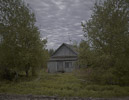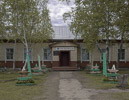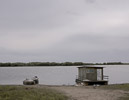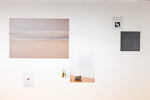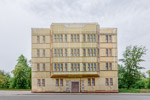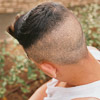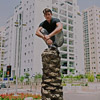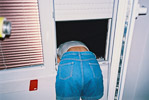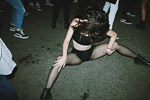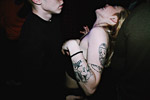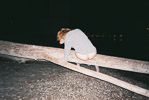1st PLACE
Alexey Pavlov
School of modern photography "Docdocdoc", Saint Petersburg, RussiaProject Name: People of the land, 2019
Description: Khabarovsk Krai in Russia’s Far East is best known for its nature. The banks of the Amur are also home to the indigenous Nanai population (the ethnonym translates simply as «people of this land»). Modern-day Nanais represent a complex historical community. Since ancient times, the Nanai people have relied on fishing not only for sustenance but also as a way of life. Today, pollution and overfishing has led to a decline of Amur salmon among other fish on the river. This has devastating repercussions for the livelihood of the Nanai people. The native language continues to be taught at schools, but according to the people I spoke to, it is given no special priority and is taught «in the same way as other foreign languages». Only some of the older generation speak their native language to a proficient degree, and nobody else speaks it in everyday life. In spite of this, the Nanai community are passionate about preserving their culture. More than a dozen national ensembles work in the Nanaian villages: the work of the Nanaian masters of arts and crafts is truly diverse and known far beyond the borders of Russia.
2nd PLACE
Hoa Nguyen Thi
Academy of Fine Arts and Design, Bratislava, SlovakiaProject Name: Memoryless, borderless and nameless space, 2019
Description: To be born as a foreigner in your own country is an existential paradox.
— M. M. Šimečka
To be someone is a relative term. The notion of belonging has its’ borders as well. Migration in the globalised world leaves the term nation hanging in the air. The move from one place to other shifts borders themselves as well as is migrant carrying his border with him. I deal with (subjective) feelings of diaspora and its’ later generations. I materialize things that create identity. I visualize things unsaid and imagine the reality that I am in. I try to base everything on the history I know although I finally run into its’ limits while asking myself what will be left after me.
3rd PLACE
Pegova Olya
School of modern photography "Docdocdoc", Saint Petersburg, RussiaProject Name: Kunststück, 2019
Description: In the past, the faux facades were rare and temporary interventions in urban spaces, but today they have become a part of the city landscape, only being changed from time to time. Looking at the windows, arches, and other architectural elements constructed in graphic editors and printed in detail, it is impossible to tell what’s hidden behind the faux facades: a historical monument awaiting reconstruction, a building in a state of disrepair concealed from the public eye, new construction space or just an empty spot. A drawn-over reality fills in the modern city landscape, shaping our perception of the world. In my work, I bring changes into the city landscape by means of digital editing, leaving the faux facades untouched. The landscapes in the photographs look familiar, but it is no longer clear what actually exists and what has been changed digitally and now only deceptively resembles the reality.
Charlen Christoph
Burg Giebichenstein University of Art and Design, Halle, GermanyProject Name: Wallpaper, 2017
Description: Walter Gropius wrote in the Bauhaus Manifesto of 1919, the barrier between artists and craftsmen should be broken. They have to join. The architecture is regarded as a complete artwork, in all its areas, exterior and interior design, furnishings. Architects, sculptors and painters were apprenticed in the Bauhaus School founded in 1919. Chairs, lamps and wallpaper were designed. With non-objective photography, I have designed wallpaper that is based on Bauhaus school design.
This is a selection of original photographs created by multiple exposures. Within the multiple exposures, I worked with different coloured light. The result is additive colour mixing. The objects in my photographs are cardboard shapes, paper cube, pieces of wood and a metal lid. I also photographed organic shapes, such as garlic core, a leaf and vibes.
Idan Simon
Bezalel Academy of Art and Design, Jerusalem, IsraelProject Name: What’s in it for me?, 2018
Description: “What's in it for me?” is a project that seeks to provide a platform for male youth from new middle class neighbourhoods in the Israeli costal town of Israel. Those areas represent more than any standardisation to the way of life that has been taking place in Israeli society in recent year. This is a significant time for them - a transitional period in which they are busy establishing independent identities as young men. More than ever, they are trying to build it up with material culture that has become significant in the way they are represented: electric bicycles, cars, telephones, clothing, and haircuts. The project seeks to expose the complex process of social mobility and the desire to create a heroic personality in the era of social routing.
Snežana Petković
Academy of Arts, Novi Sad, SerbiaProject Name: A Thing – aesthetic of grey economy, 2018
Description: A Thing / regarding the transition of an invisible object and aesthetic of grey economy by covering, the identity of things is lost and only the volume remains. The project consists of seemingly impersonal things (objects from different flea markets in the country and abroad, which my father trades) who came to me in search of their own home. These items are in transition, their character is temporary and the only thing that gives them a place in the (economic) system is a monetary currency.
These things are piled up in the corners of my home, like some forgotten monuments to everyday life; a ceramic box, an old video camera, skates, worn-out camera straps... The essence does not lie in giving importance to the individual objects, but on the contrary - they are experienced as an amorphous entity. Simultaneously they are both “the inside and the outside”, creating its own space. “The concept of things in legal terms implies the material parts of nature that can be heard and noticed, which are spatially limited and exist in the present, or for them, there are assumptions that they will exist in the future.
Jovana Semiz
Academy of Arts, Novi Sad, SerbiaProject Name: Borderline of Freedom, 2018
Description: Freedom and all the consequences that the youth carries with it. Mistakes transformed into boundaries that remain on us to cross them. We matured way before, we long for freedom and days that will allow us to do absolutely anything we want without jeopardizing our future or furthering our success. A moment of ecstasy and oblivion is the moment when my photos were taken.
Sometimes I think we are trapped in that moment of omnipotence, and in search of what it has to offer, I wonder when will we feel completely free? Do our problems come sooner, or are we just starting to act like that? Do we really feed on anything that would temporarily protect us from the truth? I grow up as my peers, and we are all equally drawn to what we are surrounded by, we are finding it increasingly difficult to accept our needs and ourselves, we are preoccupied with things that decide our future, sometimes forced to cope with a series of situations that make us tired to welcome a better tomorrow. Everyone is looking for their own way of dealing with everything that makes life difficult for them. I don’t want an album full of beautiful photos, because we’re not just that, we’re much more.




